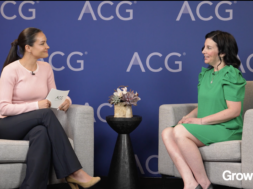A Qualified Opinion: Ari Fuchs
Ari Fuchs, a managing director at The DAK Group, recently corresponded with MMG about the dealmaking climate for manufacturing businesses, and strategies for closing a deal during the pandemic.

This article originally appeared in the November/December 2020 issue of Middle Market Growth.
Ari Fuchs is a managing director at The DAK Group, a middle-market investment bank headquartered in New Jersey. Fuchs specializes in the analysis and execution of M&A transactions, restructuring and strategic corporate advisory services. He has already closed two transactions during the COVID-19 crisis, with a number of others in various stages, yet targeted to close by year end or early 2021. He recently corresponded with MMG about the dealmaking climate for manufacturing businesses, and strategies for closing a deal during the pandemic.
Q. How has the pandemic impacted buying opportunities in the middle-market manufacturing industry?
The manufacturing industry was not immune to the disruption caused by COVID-19, and the subsequent slowdown of M&A activity in the first half of the year reflects that reality. While there were many bright spots in the manufacturing sector—including infrastructure, plastics and packaging, and food-related businesses—the pandemic-induced overhang substantially reduced the appetite for M&A. That said, we expect a pick-up in M&A activity in the second half of the year. Propelled by significant levels of private equity capital and corporate appetite for both transformative and tuck-in acquisitions, the middle market will be a direct beneficiary of the renewed levels of activity. Our own pipeline of manufacturing-related sell-side opportunities is robust and we are seeing a welcome level of eagerness and enthusiasm among strategic buyers and financial sponsors alike.
On the client side of the equation, we are definitely seeing more inquiries from tightly held family businesses, and in several instances multigenerational family businesses. Prospective sellers that were on the fence pre-pandemic have returned with a newfound willingness and desire to explore and engage in a sale transaction. Many business owners are being driven by the ongoing macroeconomic uncertainty and the desire to de-risk their overall financial picture by taking some chips off the table—a seemingly near-universal theme among our client base.
Q. The coronavirus outbreak and trade tensions have illuminated supply chain weaknesses for many businesses. Has supply chain due diligence changed as a result?
Manufacturing businesses have long recognized the economic and strategic benefits of third-party supplier relationships. These relationships are frequently the foundation of most of their day-to-day operations, providing them with a critical edge over the competition. Third-party suppliers provide an effective means for sourcing necessary expertise and resources without making costly investments needed to bring those capabilities or services in-house. Working with external suppliers, however, presents a series of challenges that must be thoroughly vetted. Pandemic-induced supply chain disruptions combined with the impact of trade tariffs has generated a renewed focus on product sourcing and supply chain efficiency, creating a new paradigm for supply chain due diligence in the context of M&A.
Supply chain due diligence has adapted to address these critical challenges. The diligence process has centered on certain key areas, such as evaluating country-specific supply chain risk, assessing the impact of force majeure clauses, evaluating supply chain flexibility in the face of possible further waves of the pandemic, as well as the availability and cost of alternative sources of supply.
Perhaps the most important takeaway for Middle-Market business owners is that the true, intrinsic value of the business is more than just a multiple of revenue or ebitda.

Q. How are you valuing companies in today’s market, at a time when performance and future earnings estimates are clouded by COVID-19 disruption?
It goes without saying that traditional valuation methods will have difficulty in accurately capturing business value in today’s M&A environment. Unexpected increases or decreases in customer demand, fluctuation in the cost of raw materials, and unusual pandemic-related expenses are some of the factors that manufacturers are currently contending with. The long-term impact of the pandemic on corporate earnings and growth remains unclear. Making matters even more challenging is the sluggish financing market for M&A transactions. With lenders focused on protecting their existing loan portfolios, there is little appetite for new investments.
For today’s middle-market business owner, this means the prospect of having to deal with depressed valuations, at least in the short term. It means deal structures are likely to change, with more earn-outs to share risk and larger equity backstops in leveraged deals.
But perhaps the most important takeaway for middle-market business owners is that the true, intrinsic value of the business is more than just a multiple of revenue or EBITDA. The true intrinsic value of a business is the value that it will bring to a strategic buyer and how it will enhance the overall earnings of the combined entity. The true intrinsic value of your business is not what it’s worth to you, but rather what it’s worth to a buyer. It’s important to identify unique, out-of-the-box buyers, buyers in adjacent verticals, or cross-border buyers that can drive significant value from your business. Consequently, these types of buyers are likely to be in a position to pay more—perhaps even an outlier value.


